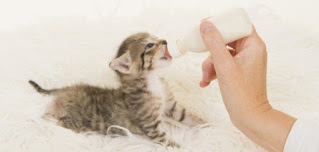How to feed kittens
How to feed a kitten Newborn cats acquire antibodies from their mothers through colostrum in the first hours of their birth, and kittens are fed with breast milk, which provides them with nutrients to increase their weight in the first weeks of their lives, then the weaning stage ofkittens from breast milk begins at the age of about a month, as solid food begins to be partially introduced into cat food, and they are able to drink water at that age.
Here's an explanation of how to feed a kitten:
Tools for feeding a kitten
The following points should be taken into account when using a bottle for feeding a kitten:
You need feeding and pipettes designed specifically for cats that make the little one breastfeed just as if he were breastfeeding from his mother, and as in breastfeeding children, there is under the pipette a regulator that controls the amount of fluid coming out of the bottle and adjusts it at an average rate, it is possible to use the syringe (syringe) as an alternative, but it does not replace the lactation, which is ideal and easier to handle.
Sterilization of small tools must be taken into account to maintain their safety, so each piece is washed separately, preferably sterilized with steam or boiling water.
Milk preparation for a kitten
If the milk is liquid, open the package and fill the bottle in the appropriate amount according to the table below, but if it is dry, you should read the instructions on the package about the proportions of mixing with water, because the low concentration of milk harms the health of the little one, and reduces the proportion of food and minerals that he takes from the meal, while the high concentration harms his intestines.
The little one must be kept warm during feeding; the cold makes the milk stay longer in his stomach and annoys him, and the cat's house can be isolated and put a warm bag under it or a hot water can to maintain its heat, but it must be wrapped in a towel so as not to burn the skin of the little one, and replace it when needed to keep the little one warm.
A suitable chair is placed with a towel wrapped around the knee of the person who will breastfeed, then he carries the little one and puts him in a position suitable for breastfeeding as if he were going to be breastfed by his mother, where his head is straight, his feet are down, and his stomach is lying down, and when trying to breastfeed the cat for the first time, a drop of milk is withdrawn from the tip of the syringe or pipette and it is brought closer to the mouth of the baby;
When dealing with lactation, you must try to push it - but gently and without effort - inside the mouth of the little one, and then his instinct will help him to continue feeding, but if you use the syringe, you can press gently on it to get the milk into the mouth of the little one and suck it, and do not put a large amount of milk in his mouth, because it is possible to choke on it, he cannot control the lactation process, and he must be breastfed very quietly and slowly.
The position of the little one is very important, he should not be placed on his back during feeding, and he should be placed on top of something comfortable, and his head should not rise during feeding so that nothing of milk leaks into his lungs, causing inflammation for him.
You should not provide more food than needed, and it is possible to monitor the extent to which his stomach is full by pressing on the abdomen; if the stomach protrudes and looks solid, you must stop feeding him immediately even if the little one is still asking for food, and if the little one eats less than he needs, it does not matter, you should stop at his desire and try to feed him again after he rests.
You must maintain calm when feeding the baby, so that he feels comfortable and takes his needs, especially when feeding him for the first time.
The cat must be made burp to get out the air in his stomach, by carrying it and making his back in the palm of the hands of the person who breastfeeds it, while massaging his stomach with the other hand to get out the air in his stomach, and sometimes the stool comes out, and this is an excellent sign of his health.
After each meal, the mother cat usually licks the body of its young, especially the area and genitals to stimulate it to urinate and excrete, so that these wastes do not remain inside the body of the little one and harm him, and a person can use a cotton ball to wipe the body of the kitten to get an approximate effect, and this step is very important to end the feeding process, and other than that, the cat faces many diseases from the accumulation of waste inside it.
This process continues until the cat is able to feed itself.
If the little one bites the sucker, this is a positive sign, and if the little one does not want to eat solid food when served, milk can be added in a small amount to him, in order to encourage him and to make his food softer, and it is preferable to leave the food in front of the little one to enjoy biting it whenever he wants to, while starting to gradually reduce milk meals in exchange for solid food.
At the age of seven weeks the young becomes able to completely rely on himself in food.
Things to consider when feeding a baby cat
It is important to pay attention to the following:
The milk should be fresh and fresh for each meal and free of preservatives, because the immunity of newborn cats is not strong, as any contamination in the milk causes the little one to become ill. Microwave or direct fire heating should not be used to make milk, and a hot water bath can be used instead. Milk should be moderately hot with a body temperature between 38-37 degrees Celsius, and it can be examined by placing drops of it on the back of the hand, if it is neither cold nor hot, it is suitable, because cold bothers the small and hot burns his mouth.
Ways to care for a newborn cat
Searching for a surrogate mother
The first attempts that can be made to take care of a kitten is to find another mother who works to take care of it, and this is the best thing that can be done if it is available, and it is possible to review reserves or places of breeding and caring for cats to find a mother who takes care of the little one, because breast milk remains the best for the young, and the most able to feed it and raise its immunity.
And because cats are the most able to raise their young, but you must be very careful and careful that some cats are hostile to any young strangers to them; the new mother may refuse to breastfeed the little one, and may try to harm him, so they must be carefully monitored when they are placed together, until they get along or until the mother rejects the little one, and then another alternative can be searched.
Offering milk to the little one
If the mother rejects the little one and it is not possible to get another mother, a person must take over this task, by choosing suitable milk and offering it to the little one, and what is suitable for cats is cat milk only, and cow's milk cannot be used for this purpose, as it harms the health of the child.
Cow's milk is likely to cause diarrhoea, dehydration, nutritional deficiencies, and long-term health problems due to poor physiology resulting from malnutrition, and because of the extreme nutritional poverty in cow's milk relative to what kittens need.
Warning: Milk cans coated with cartons and printed on them (suitable for cats) are not useful for baby cats, because they are prepared from cow's milk after removing lactose sugar from it, so they can be given to large cats without health damage, but they will remain poor in food for a kitten.
One-time temporary solution
When there is no possibility of obtaining milk, the best solution (under these circumstances) is to boil water, add a spoonful of ground glucose sugar to it and offer it to the little one directly, especially if he is hungry, and this meal is served only once without relying on it in the long term, and it only aims to save more time to find a source of cat milk.
Rice water can also be used for its richness in nutrients, its ability to provide energy to the little one, and providing water to the little one better than leaving it dehydrated and undernourished, and better than providing cow's milk with bad side effects, but it will leave the cat to develop hunger in the long run.
Cats are domestic animals that reproduce by birth, as the infant animal needs care from the mother for at least two months, during which the mother breastfeeds her baby and protects him from dangers. There are many ways through which the kitten can be fed if it loses its mother, or when raising the kitten at home, as some sterile tools are used to breastfeed it, and appropriate milk must be given to its body at a certain concentration, taking into account some measures to be followed to provide full care for it.


Commentaires
Enregistrer un commentaire